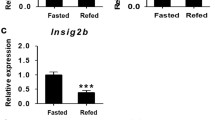Abstract
Peroxisome proliferator (PPAR)α ligand Wy14,643 induces liver-fatty acid binding protein (FABP) spontaneously and heart-FABP gradually, but not intestine-FABP mRNA expression in the mouse liver. These strict regulations have not been reproduced in cultured cell systems. We applied a DNA electroporation method to directly introduce reporter gene constructs into the livers of mice. This system reproduced the in vivo responses of the above three FABP gene promoters to the PPARα ligand but not that of a promoter containing the typical three PPAR binding sites in tandem. Deletion and mutation analyses of the mouse L-FABP gene suggested that, in addition to the binding site for PPARα, a far upstream sequence is required for PPAR-dependent transactivation in the liver. In contrast to the cultured cell systems, our in vivo DNA electroporation method showed that PPARα binding to the promoter is necessary but not sufficient for PPARα ligand-dependent transcriptional activation of the L-FABP gene in vivo.
Similar content being viewed by others
References
Kliewer SA, Xu HE, Lambert MH, Willson TM: Peroxisome proliferator-activated receptors: From genes to physiology. Recent Prog Horm Res 56: 239–263, 2001
Kersten S, Desvergne B, Wahli W: Roles of PPARs in health and disease. Nature 405: 421–424, 2000
Juge-Aubry C, Pernin A, Favez T, Burger AG, Wahli W, Meier CA, Desvergne B: DNA binding properties of peroxisome proliferator-activated receptor subtypes on various natural peroxisome proliferator response elements. Importance of the 5′-flanking region. J Biol Chem 272: 25252–25259, Date?
Lee SS, Pineau T, Drago J, Lee EJ, Owens JW, Kroetz DL, Fernandez-Salguero PM, Westphal H, Gonzalez FJ: Targeted disruption of the alpha isoform of the peroxisome proliferator-activated receptor gene in mice results in abolishment of the pleiotropic effects of peroxisome proliferators. Mol Cell Biol 15: 3012–3122, 1995
Glatz JFC, Storch J: Unrevelling the significance of cellular fatty acidbinding proteins. Curr Opin Lipid 12: 267–274, 2001
Heuckeroth RO, Birkenmeier EH, Levin MS, Gordon JI: Analysis of the tissue-specific expression, developmental regulation, and linkage relationship of a rodent gene encoding heart fatty acid binding protein. J Biol Chem 262: 9709–9717, 1987
Motojima K: Differential effects of PPARα activators on induction of ectopic expression of tissue-specific fatty acid binding protein genes in the mouse liver. Int J Biochem Cell Biol 32: 1085–1092, 2000
Sweetser DA, Lowe JB, Gordon JI: The nucleotide sequence of the rat liver fatty acid-binding protein gene. Evidence that exon 1 encodes an oligopeptide domain shared by a family of proteins which bind hydrophobic ligands. J Biol Chem 261: 5553–5561, 1986
Green RP, Cohn SM, Sacchettini JC, Jackson KE, Gordon JI: The mouse intestinal fatty acid binding protein gene: Nucleotide sequence, pattern of developmental and regional expression, and proposed structure of its protein product. DNA Cell Biol 11: 31–41, 1991
Treuner M, Kozak CA, Gallahan D, Grosse R, Muller T: Cloning and characterization of the mouse gene encoding mammary-derived growth inhibitor/heart-fatty acid-binding protein. Gene 147: 237–242, 1994
Motojima K, Passilly P, Peters JM, Gonzalez FJ, Latruffe N: Expression of putative fatty acid transporter genes are regulated by peroxisome proliferator-activated receptor α-and γ-activators in a tissue-and inducer-specific manner. J Biol Chem 273: 16710–16714, 1998
Dignass AU, Podolsky DK: Interleukin 2 modulates intestinal epitherial cell function in vitro. Exp Cell Res 225: 422–429, 1996
Saitoh O, Periasamy M, Kan M, Matsuda R: Cis-4-hydroxy-L-proline and ethyl-3,4-dihydroxybenzoate prevent myogenesis of C2C12 muscle cells and block MyoD1 and myogenin expression. Exp Cell Res 200: 70–76, 1992
Chomczynski P, Sacchi N: Single-step method of RNA isolation by acid guanidinium thiocyanate-phenol-chloroform extraction. Anal Biochem 162: 156–159, 1987
Motojima K, Peters JM, Gonzalez FJ: PPARα mediates peroxisome proliferator-induced transcriptional repression of non peroxisomal gene expression in mouse. Biochem Biophys Res Commun 2130: 155–158, 1997
Galli A, Pinaire J, Fischer M, Dorris R, Crabb DW: The transcriptional and DNA binding activity of peroxisome proliferator-activated receptor alpha is inhibited by ethanol metabolism. A novel mechanism for the development of ethanol-induced fatty liver. J Biol Chem 276: 68–75, 2001
Nomura T, Nakajima S, Kawabata K, Yamashita F, Takakura Y, Hashida M: Intratumoral pharmacokinetics and in vivo gene expression of naked plasmid DNA and its cationic liposome complexes after direct gene transfer. Cancer Res 57: 2681–2686, 1997
Nomura T, Yasuda K, Yamada T, Okamoto S, Mahato RI, Watanabe Y, Takakura Y, Hashida M: Gene expression and antitumor effects following direct interferon (IFN)-γ gene transfer with naked plasmid DNA and DC-chol liposome complexes in mice. Gene Ther 6: 121–129, 1999
Hisayasu S, Miyauchi M, Akiyama K, Gotoh T, Satoh S, Shimada T: In vivo targeted gene transfer into liver cells mediated by a novel galactosyl-D-lysine/D-serine copolymer. Gene Ther 6: 689–693, 1999
Muramatsu T, Ito N, Tamaoki N, Oda H, Park H-M: In vivo gene electroporation confers nutritionally-regulated foreign gene expression in the liver. Int J Mol Med ``7: 61–66, 2001
Ricote M, Li AC, Willson TM, Kelly CJ, Glass CK: The peroxisome proliferator-activated receptor-γ is a negative regulator of macrophageactivation. Nature 391: 79–82, 1998
Motojima K: Peroxisome proloferator-activated receptor (PPAR)-dependent and-independent transcriptional modulation of several nonperoxisomal genes by peroxisome proliferators. Biochimie 79: 101–106, 1997
Akiyama TE, Ward JM, Gonzalez FJ: Regulation of the liver fatty acid-binding protein gene by hepatocyte nuclear factor 1α (HNF1α). Alteration in fatty acid homeostasis in HNF1α-deficient mice. J Biol Chem 275: 27117–27122, 2000
Hsu M-H, Savas Ñ, Griffin KJ, Johnson EF: Identification of peroxisome proliferator-responsive human genes by elevated expression of the peroxisome proliferator-activated receptor in HepG2 cells. J Biol Chem 276: 27950–27958, 2001
Author information
Authors and Affiliations
Rights and permissions
About this article
Cite this article
Fujishiro, K., Fukui, Y., Sato, O. et al. Analysis of tissue-specific and PPARα-dependent induction of FABP gene expression in the mouse liver by an in vivo DNA electroporation method. Mol Cell Biochem 239, 165–172 (2002). https://doi.org/10.1023/A:1020546606429
Issue Date:
DOI: https://doi.org/10.1023/A:1020546606429




